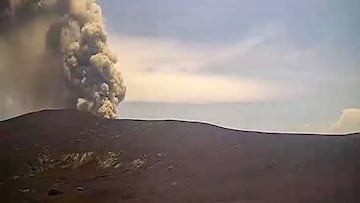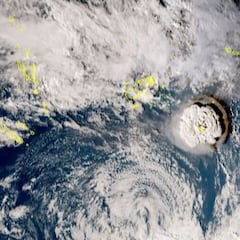Indonesia issues tsunami warning over Anak Krakatoa eruption
Authorities raised the warning level over the volcano to its second highest level and extended the exclusion zone around the crater.

Volcano Anak Krakatoa is once again worrying Indonesia. After the recent eruption from one of the volcano’s craters the Indonesian meteorological department (BMKG) has raised its risk assessment to level 3, just one below the highest. The highly active stratovolcano is considered one of the most dangerous in the world.
Anak Krakatoa, meaning Child of Krakatoa, is an island volcano that is growing out of the caldera (emptied magma chamber) of the island of Krakatoa and its archipelago, that was destroyed in an almighty eruption in 1883. The new volcano itself erupted and then collapsed in 2018, causing a deadly tsunami, and there has been ongoing activity at the site since.
Exclusion zone extended around Anak Krakatoa
Indonesian authorities have extended the exclusion zone around the volcano to five kilometres, as they aim to take all precautionary measures to protect human life over the volcanic activity occurring at the site, located between the islands of Java and Sumatra, in the Strait of Sonda.
The BMKG has warned populations living on nearby islands of the risk of tsunamis caused by the activity at Anak Krakatoa.
Mask recommendation in place for Anak Krakatoa eruption
Due to the emissions of ash and gases, people living in the vicinity of the volcano have been advised to wear masks.
This is not the first time the volcano has erupted this year. Over the past four months, the crater has seen 21 distinct eruptions. On February 3, there was a phreatic eruption, also known as a steam-blast eruption, when magma heats water, with the heat causes the water to evaporate near-instantaneously, resulting in an explosion of steam, water, rock and ash. In this instance however the explosion did not result in new magma reaching the surface.
In the most recent eruption the volcano emitted a cloud of smoke and ash that reached an altitude of 10,000 feet. The Indonesian Geological Agency has asked both residents and tourists to follow all recommendations issued by experts.
Volcanic activity at the Krakatoa site
In 2018 the eruption and subsequent collapse at the volcano caused a tsunami that killed over 400 people and injured around 14,000, with 40,000 displaced. It affected more than 186 miles of coastline around Sumatra and Java. This is currently the second-deadliest volcanic eruption of the 21st century.
Related stories
The original destruction of Krakatoa, in 1883, is considered one of the largest ever in modern geological history, exploding with a force of 13,000 atomic bombs of the type dropped on Hiroshima in 1945. The noise of the blast was heard up to 3,500 kilometres away. Over 36,000 people were killed by the explosion, as a consequence of pyroclastic flows, volcanic ash and tsunamis.
Pacific Ring of Fire
Anak Krakatoa is located on the Pacific Ocean’s Ring of Fire, an area of major volcanic and seismic activity, caused by the collision of tectonic plates underneath the boundaries of the Pacific.

